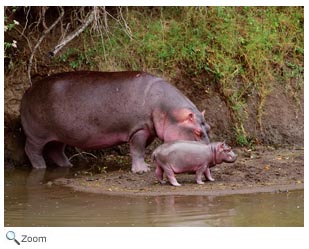Hippopotamidae - hippopotamuses
 There are two living species and one extinct in this family. They are found in
lakes, swamps, and rivers in Sub-Saharan Africa. There are two living species and one extinct in this family. They are found in
lakes, swamps, and rivers in Sub-Saharan Africa.
Hippos have large heads; large, round bodies; small ears; and short tails. They have thick, gray skin lightly covered in hair and short, stumpy legs. Their ears, eyes, and nose are on the top of their heads. This lets the hippo submerge most of its body in water and keep it nose and eyes above the water line so it can breathe and keep an eye out for danger.
The hippo lives in herds of up to 40 individuals. It spends most of the day in the water. At night, it emerges from the water to graze on vegetation.
World Status Key
 Least Concern Least Concern  Near Threatened Near Threatened  Vulnerable Vulnerable  Endangered Endangered  Critically Endangered Critically Endangered  Extinct in Wild Extinct in Wild  Extinct Extinct
Status taken from ICUN Redlist. If no status is listed, there is not enough data to establish status, or there is no status data for the species.
US Status Key
 Threatened in US Threatened in US  Threatened in NH Threatened in NH  Endangered in US Endangered in US  Endangered in NH Endangered in NH  Introduced Introduced
Status taken from US Fish and Wildlife and NH Fish and Game
New Hampshire Species |
|
North/Central American Species |
| None |
|
None |
Additional Information Resource Key
 Profile Profile  Photos Photos  Video Video  Audio Audio
Pygmy Hippopotamus - Choeropsis liberiensis     
The pygmy hippopotamus is much smaller than the hippopotamus. It eyes are also not quite as far on the side of its head as those of the hippopotamus.
Source: Arkive Intended Audience: General Reading Level: Middle School
Pygmy Hippopotamus - Choeropsis liberiensis    
In 1927 rubber baron Harvey Firestone gave President Calvin Coolidge a male pygmy hippo named Billy. Billy is the ancestor to almost all pygmy hippos living in American zoos.
Source: National Zoo Intended Audience: General Reading Level: Elementary/Middle School
Pygmy Hippopotamus - Choeropsis liberiensis    
The pygmy hippopotamus is usually solitary but can sometimes be found in small family groups.
Source: San Diego Zoo Intended Audience: General Reading Level: Elementary/Middle School
Pygmy Hippopotamus - Choeropsis liberiensis    
The pygmy hippopotamus is found in Liberia, Ivory Coast, Sierra Leone, and Guinea.
Source: Animal Diversity Web Intended Audience: General Reading Level: Middle/High School
Hippopotamus - Hippopotamus amphibius    
The name hippopotamus comes from the Greek word meaning "river or water horse."
Source: San Diego Zoo Intended Audience: General Reading Level: Elementary/Middle School
Hippopotamus - Hippopotamus amphibius     
The hippopotamus is very graceful under water!
Source: Arkive Intended Audience: General Reading Level: Middle School
Hippopotamus - Hippopotamus amphibius    
The hippopotamus is also known as the Nile hippopotamus.
Source: National Zoo Intended Audience: General Reading Level: Elementary/Middle School
Hippopotamus - Hippopotamus amphibius     
The hippopotamus is the third-largest living land mammal, after elephants and white rhinos.
Source: African Wildlife Federation Intended Audience: General Reading Level: Middle School
Hippopotamus - Hippopotamus amphibius     
Female hippos give birth away from the herd, while submerged underwater.
Source: Los Angeles Zoo Intended Audience: General Reading Level: Elementary/Middle School
Hippopotamus - Hippopotamus amphibius    
Hippos spend most of their time in the water with only their eyes and nostrils exposed.
Source: Philadelphia Zoo Intended Audience: General Reading Level: Elementary/Middle School
Hippopotamus - Hippopotamus amphibius   
Hippos cans stay underwater for up to 5 to 6 minutes.
Source: Enchanted Learning Intended Audience: Students Reading Level: Elementary School |

